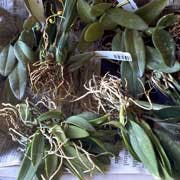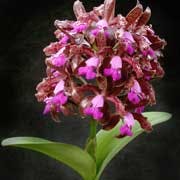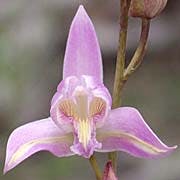B
bacillaris, -e (bass-ill-AIR-iss) Stick- or stafflike.
backbulb (bak-buhlb) An old pseudobulb, often without leaves but still alive and bearing one or more eyes, frequently used for propagation, located behind the actively growing portion of a sympodial orchid.
back cross (bak-KROSS) A mating between hybrid progeny and one of the original parents.
bactericide (bak-TEER-i-side) A chemical substance that destroys bacteria.
bambusifolius, -a, -um (bam-boo-see-FOH-lee-us) Bamboo-leaved.
banded (BAN-did) Marked with crossbars or horizontal lines of color, or with very prominent ribs or other structure.
Baptistonia (bap-tist-OWN-ee-ah) A monotypic epiphytic genus endemic to Brazil founded in 1877 by Barbosa Rodriques and named in honor of Dr. Baptista Caetano d'A Nogueira. This genus is closely related to Oncidium and many taxonomists now consider it to be a synonym of the latter.
barb (barhrb) A short point or bristle; usually employed to designate points with reflexed or hooklike appendages.
barbatulus, -a, -um (bar-BAT-yew-lus) Somewhat bearded; the beard small.
barbatus, -a, -um (bar-BAY-tus) Bearded, i.e., provided or beset with long weak hairs or terminating in a mass of hairs, usually more or less straight and parallel. The negative is expressed by imberbis.
barbigerus, -a, -um (bar-BIJ-er-us) Bearded or bearing a beard, alluding to the fringed lip of many plants.
Barbosella (bar-bow-SELL-ah) A genus of epiphytic orchids ranging from Costa Rica south to Argentina. Schlechter described the genus in 1918. The name honors Dr. João Barbosa Rodrigues, a Brazilian botanist. Some taxonomists consider there to be as many as 70 or more species while the World Checklist of Monocotyledons recognizes 19.
barbulatus, -a, -um (bar-bew-LAY-tus) Somewhat bearded, or with fine or short beard; barbulate bark. The word is often used in a general way to designate the softer outer envelope of a stem or root. In this sense, it includes all that peels readily, as the bark of the hemlock and oak, used for tanning leather. In a stricter sense, it is applied to the corky layers formed on the outer surface of woody plants. It is formed from the active layer of tissue, the phellogen.
bare-root: Recently imported bare-root orchids. Orchids that are devoid of any potting media.

bare-root (bair-root) of or pertaining to a plant prepared for transplanting or repotting by having all or most of the medium removed from its roots.
Barkeria (bar-CARE-ee-ah) A genus of 15 Mesoamerican species with a diversity in Mexico, previously included in a broadly defined Epidendrum.
Barlia (BAR-lee-ah) A small terrestrial genus of two species from southern Europe and northern Africa. Parlatore described the genus in 1858, naming it in honor of the Italian botanist Sr, Barla, who collected the original material.
Bartholina (barth-oh-LEE-nah) The two terrestrial species in this genus can be found in Cape Town, South Africa. The genus was founded by Robert Brown in 1813 and named in honor of Thomas Bartholin, a Danish anatomist.
basal (BAY-suhl) At or close to the base.
basilaris, -e (bay-sil-AIR-iss) Pertaining to or at the bottom; basal.
basket (BASS-kit) A container for growing orchids, usually made of interlocked strips of wood, that offers maximum drainage and aeration of the growing medium.
basitonic (BASE-eh-tawn-ick) When the rostellum or viscidium are connected to the base of the anther.
Bateman, James (1811—1897) An English orchidist and orchidologist, noted for his several outstanding books on orchids, particularly the elephantine volume Orchids of Mexico and Guatemala, published 1837—1843, and A Monograph of Odontoglossum.
Batemannia (bayt-MAN-nee-ah)A genus of epiphytic orchids with about five species from northern South America, closely related to Lycaste, Zygosepalum and Promenaea, it was founded in 1834 by Lindley in compliment to James Bateman.
Bauer, Franz Andreas (1758—1840) An outstanding botanical illustrator and artist who worked with Lindley on orchids.
beak (beek) A long, prominent and substantial point, applied particularly to prolongations of fruits and carpels.
Beallara (bee-ul-AH-rah) A former hybrid genus derived from Brassia, Cochlioda, Miltonia and Odontoglossum, it was created in 1970 and named after Beall's Nursery. With the reorganization of the Onciidinae, this hybrid genus now becomes Aliceara.
beard (beerd) A long awn or bristle-like hairs.
bellus, -a, -um (BELL-us) Beautiful; handsome.
Bentham, George (1800—1884) An English botanist who was joint author with Dr. J.D. Hooker in the monumental work Genera Plantarum, a treatment of all genera of plants known at that time (Vol. III, Orchideae, pp. 460—636, 1883).
bi- or bis- (BYE, BISS) In Latin compounds, signifying "two" or "twice."
bialatus, -a, -um (bye-ah-LAY-tus) Two-winged.
bicalcaratus, -a, -um (bye-kal-ka-RAY-tus) Two-spurred; having two spurs; bicalcarate.
bicallosus, -a, -um (bye-kal-LOH-sus) Having two calluses, or hard projections on lip.
bicameratus, -a, -um (bye-kam-er-RAY-tus) Having two chambers; bicameral.
bicolor (BYE-koll-or) Two-colored.
bicornis, -e (bye-KORN-is) Two-horned; having two horns or hornlike spurs.
bicornutus, -a, -um (bye-kor-NEW-tus) Two-horned.
bictoniensis, -e (bik-toh-nee-EN-sis) Of Bicton, near Sidmouth, England and refers to the house of Lord Rolle.
bidens (BYE-denz) Two-toothed.
bidentatus, -a, -um (bye-den-TAY-tus) Having two teeth; bidentate.
biennial (BYE-en-ee-uhl) Of two seasons' duration from seed to maturity and death.
bifarious (bye-FAIR-ee-us) Arranged in two rows.
bifidus, -a, -um (BYE-fid-us) Split in two to the middle; divided into two equal parts; bifid.
Bifoliate: Cattleya tigrina has two leaves and is a bifoliate Cattleya.

bifoliate (BYE-foll-ee-it) Having two leaves; two-leaved.
biforate (BYE-for-ayt) With two openings, pores or apertures.
Bifrenaria (bye-fren-AIR-ee-a) A genus of about 21 species related to Lycaste, from Central and South America, described by Lindley in 1833, the name alluding to the two caudicles on the pollinia.
bifurcatus, -a, -um (bye-fur-KAY-tus) Two-forked or two-pronged; bifurcate.
bigeneric (bye-jen-AIR-ik) Involving two distinct genera in the parentage; applied to hybrids.
bigibbus, -a, -um (bye-GIB-bus) Having two small protuberances.
bilabiate (BYE-lay-bee-it) Two lips.
bilamellatus, -a, -um (bye-lam-ell-LAY-tus) Bearing or consisting of two plates; bilamellate.
bilateral (bye-LATT-er-al) Having a body composed of only two corresponding halves, each half a mirror image of the other.
bilobate (bye-LOH-bayt) Two-lobed; parted into two lobes; bilobed.
bilocular (bye-LOCK-yew-lar) Two-celled; with two locules or compartments.
bipartite (bye-PAR-tite) Divided into two parts; separated nearly to base.
bipinnatus, -a, -um (bye-pin-AY-tus) Twice-pinnate; when the primary divisions are pinnate.
bipunctatus, -a, -um (by-punk-TAY-tus) Having two dots or spots.
bisexual (bye-SEKS-yew-al) Two-sexed; with both stamens and pistils.
Bl See Brassolaelia.
blade (bleyd) The expanded portion of a leaf or floral segment.
blandus, -a, -um (BLAN-dus) Pleasing; charming; tempting; alluring.
Blc See Brassolaeliocattleya.
Bletia: Bletia purpurea is a widespread species of the Americas and Caribbean.

Bletia (BLEE-tee-a or BLAY-tee-ah)) A genus of American terrestrial orchids comprising some 35 species with greatest diversity in Mexico, resembling Spathoglottis, described by Ruiz and Pavon in 1794 in honor of Don Luis Blet, a Spanish apothecary of the 18th century, who maintained a botanic garden in Algeciras.
Bletilla (blee-TILL-a or blay-till-ah) A genus of terrestrial orchids with around five species from (the region embracing China, Japan and Formosa), allied to the American genera of Arethusa and Calopogon, it was described by Reichenbach in 1853, the name implying its resemblance to the genus Bletia, to which it is only distantly related. Sold commercially as hardy Chinese orchid.
bloom (bloom) A white powdery covering on the surface, may be waxy. Also another name for a flower.
Blume, Karl Ludwig (1796—1862) An early Dutch botanist who worked extensively on the flora of the area now known as Indonesia. He described many orchids including Phalaenopsis.
boisduval scale (BWAS-doo-vahl skayl) A pernicious sucking insect characterized by white extruded waxy coatings.
boliviensis, -e (bo-liv-ee-EN-sis) Native of Bolivia; Bolivian.
Bolusiella (bowl-us-EE-ell-ah) There are about six epiphytic species in this tropical African genus. Schlechter named the genus in 1918 in honor of Sir Harry Bolus, a pioneer South African botanist.
Bollea (BOH-lee-a) A genus of 10 species of high-elevation South American epiphytic orchids allied to Huntleya and Cochleanthes. It was described by Reichenbach in 1852, being dedicated to Dr. Karl Bolle, a German patron of horticulture. This genus is now considered by many taxonomists to be synonymous with Pescatorea.
Bolus, Henry (1834—1911) A British botanist and student of the orchids of South Africa, author of the three-volume work Orchids of South Africa, published 1893—1913.
Bonatea: Bonatea speciosa is an African terrestrial.

Bonatea (bone-AH-tee-ah) A tropical South African genus of approximately 17 species of terrestrial orchids. The genus was named by Wildenew in 1805 in honor of the Italian botanist M. Bonat.
borealis, -e (bor-ee-AL-iss) Northern; of the north.
boss (baws) A prominent center or projection on a flat and more or less circular surface.
botanical (bo-TAN-i-kul) A term designating any species, genus or orchid that is not grown commercially for its flowers.
Bothriochilus (both-ree-oh-KYE-liss) There are four species in this genus native from Mexico south to Panama. Lemaire described the genus in 1852, coining the name from two Greek words meaning "small hollow tip." The species in this genus may be epiphytic, terrestrial or lithophytes. The genus is now considered by many taxonomists to be synonymous with Coelia.
Boxall, William (1884—1910) A British orchid collector who worked extensively in tropical Asia, especially in the Philippines, and whose name is commemorated in numerous species.
Brachtia (brackt-EE-ah) This epiphytic genus was named in honor of an Austro-Hungarian military officer, Captain Bracht, who collected plants in northern Italy. H.G. Reichenbach described this genus of seven Andean species in 1850. It closely resembles Brassia
brachiatus, -a, -um (brack-ee-AY-tus) Branched or having arms; in Brassia it refers to the very long tails; brachiate.
Brachycorythis (brack-ee-ko-RYE-thiss) A genus of about 36 species of tropical African and Asian terrestrial orchids somewhat related to Orchis and to Habenaria. It was described by Lindley in 1838, the name derived from the Greek meaning "short helmet" in allusion to the shape of the flowers.
brachypetalus, -a, -um (brack-ee-PET-a-lus) Having petals like arms.
bract (brakt) A reduced leaflike or scalelike organ embracing the base of the flower stem or aggregation of flowers.
bracteatus, -a, -um (brack-tee-AY-tus) Bracted; having several or many bracts; bracteate.
bracteiform (BRACK-tee-form) Of the shape and form of a bract.
bracteole (BRACK-tee-ohl) A small bract.
bracteosus, -a, -um (brak-tee-OH-suss) With numerous or conspicuous bracts.
bractescens (brak-TESS-enz) Having very large bracts or a strong tendency to develop bracts.
brasiliensis, -e (brah-zil-ee-EN-siss) Native of Brazil; Brazilian.
Brassavola (bra-SAH-voh-lah) A genus of about 20 tropical American orchids closely allied to Cattleya and Laelia, described by Robert Brown in 1813 and dedicated to Sr. Antonio Musa Brasavola, a Venetian nobleman and botanist. Sometimes called "lady of the night" because of the nocturnal fragrance.
brassavolae (bra-SAH-voh-lye) Like a Brassavola.
Brassia (BRASS-ee-ah) A genus of about 35 species in the Oncidium alliance characterized by spiderlike flowers, described by Robert Brown in 1813 in honor of William Brass, an 18th-century botanical illustrator.
Brassocattleya (brass-oh-CAT-lee-ah) A hybrid genus between Brassavola and Cattleya, with the first artificial hybrid created in 1889.
Brassoepidendrum (brass-oh-ep-i-DEN-drum) A hybrid genus between Brassavola and Epidendrum created in 1906.
Brassolaelia (brass-oh-LEE-lee-ah; brass-oh-LYE-lee-ah) A hybrid genus between Brassavola and Laelia created in 1898.
Brassolaeliocattleya (brass-oh-LEE-lee-oh-KAT-lee-ah; brass-oh-LYE-lee-oh-KAT-lee-ah) A hybrid genus derived from Brassavola, Laelia and Cattleya created in 1897.
breaking (BRAY-king) Said when vegetative buds start to grow.
brevis, -e (BREV-is) Short; abbreviated.
brevifolius, -a, -um (brev-ee-FOH-lee-us) Short-leaved.
breviscapus, -a, -um (brev-ee-SCAY-pus) Having a short scape or flower stalk.
bristly (BRISS-lee) Bearing stiff strong hairs or bristles.
Broadway, Walter E. (1863—1935) An English gardener and botanist who collected in Trinidad, Venezuela and French Guiana, devoting his major years to the flora of Trinidad, especially the orchids; his name now commemorated in several species.
Bromheadia (BROM-HEAD-ee-ah) Lindley established the genus in 1841, naming it in honor of Sir E.F. Bromhead, F.R.S, a student of botany and a friend of Lindley. The are about 28, mostly terrestrial, species ranging from Thailand south to northeast Australia and east to the Philippines.
Broughtonia (brow-TOH-nee-ah) A genus of about seven species, attractive epiphytic orchids from the island of Jamaica, related to Laelia and Cattleya. It was established by Robert Brown in 1813, being dedicated to Arthur Broughton, an English botanist who worked in Jamaica in the early 19th century.
Brown, Robert (1773—1858) A prominent British botanist whose contributions include early observations on the cell nucleus and pollinaria in addition to numerous taxonomic descriptions.
brumalis, -e (broo-MAY-lis) Winter-flowering.
brunneus, -a, -um (BROON-ee-us) Brown; russet.
buccinator (BYEW-sin-ay-ter) Trumpeter; shaped like a crooked trumpet or shepherd's horn.
bucephalus (byew-SEFF-a-lus) From the Greek, boukephalos (ox-head) and refers to the appearance of an ox or bull's head.
bud (buhd) An incipient or nascent shoot; the rudimentary or beginning state of a stem; in common speech, a thickened and condensed resting stage of a shoot, a flower or a leaf before expanding.
bud initiation (buhd ih-nish-ee-AY-shun) The early stage of differentiation of the primordial flower stem and flowers.
bufo (Boo-foh) Resembling a toad.
bulb (buhlb) A thickened part in a resting state made up of scales or plates on a much shortened axis; an informal term for pseudobulb.
bulb pan (buhlb pan) A shallow pot, typically one third the height of a standard pot, commonly used for genera such as Pleione.
bulbiferus, -a, -um (bul-BIFF-er-us) Bulb-bearing.
Bulbophyllum (bulb-oh-FILL-um) A genus of some 1,000 species of orchids, primarily African and Asiatic, described by du Petit-Thouars in 1822, the name referring to the fleshy leaves borne singly on prominent pseudobulbs. See also Cirrhopetalum.
bulbosus, -a, -um (bohl-BOH-sus) Having bulbs; bulblike; with the structure or characteristics of a bulb; bulbous.
bulbiformis, -e (buhl-bi-FORM-is) Shaped like a bulb; bulbiform.
bullatus, -a, -um (bull-AY-tus) With a surface blistered or puckered, as the leaf of a Savoy cabbage; inflated; bullate.
Burgeff, Hans (1883—1976) Professor of Botany and Director of the Botanical Institute at W—rzburg, Germany, noted for his work on orchid mycorrhiza and orchid seed germination, and recipient of the American Orchid Society's Gold Medal of Achievement at the Third World Orchid Conference (1960).
Burrage, Albert C. (1859—1931) An outstanding patron of horticulture from Massachusetts who assembled one of the country's finest collections of orchids, he served as the first President of the American Orchid Society from 1921 to 1929.
bursicle (BER-sick-ul) A pouchlike receptacle.
bush house (boosh hous) A slat house.
Buysson, R. Du (1871—1893) French horticulturist and author of Des Orchidees (1878), commemorated by Doritis buyssoniana.









